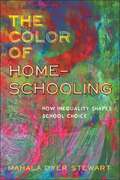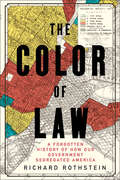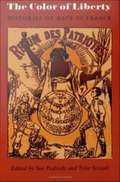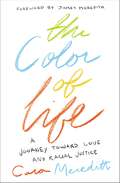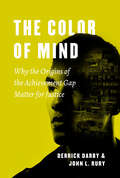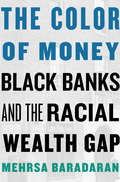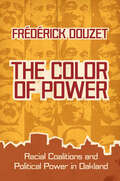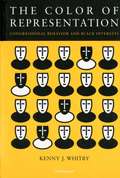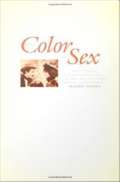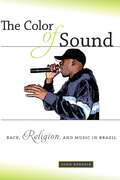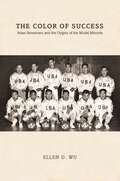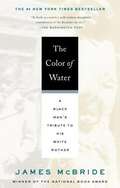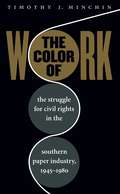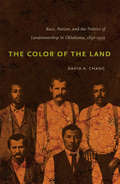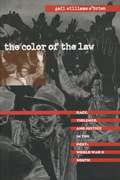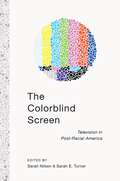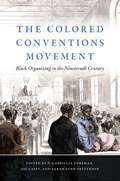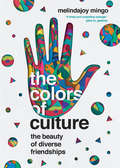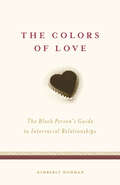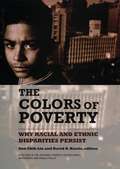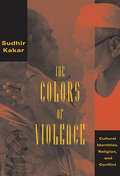- Table View
- List View
The Color of Gender: Reimaging Democracy
by Zillah R. EisensteinIn this provocative volume, Zillah Eisenstein uncovers the hidden sexual and racial politics of the past decade. Beginning where she left off in her award-winning book The Female Body and the Law, Eisenstein takes the reader on a feminist-inspired road trip, traveling from the thicket of recent abortion decisions to the revolutions of 1989 to the murky chambers of the Anita Hill/Clarence Thomas hearings. Along the way, she enunciates a wholly original conception of individual privacy and sexual rights.Eisenstein brings a range of topics to her discussion: the L.A. riots, crack babies, Murphy Brown, political correctness, the 1992 presidential election, the Gulf War. She seeks to redirect our thinking about democracy away from universal conceptions that mask racial and gender oppression to the specific realities of women and people of color. A respect for multiple differences—as represented in the needs of women of color and their bodies—is, she says, essential to inclusive universal rights. Reproductive freedoms and sexual equality, not abstract notions of civil liberties, provide the wellsprings of a meaningful democratic life. Using this perspective to evaluate the Eastern European revolutions of 1989, Eisenstein finds that the separation between their ideals and the reality of the market system illustrates the failings of democratic theory, especially for women.Eisenstein's controversial arguments will provoke a rethinking of what race and gender mean today.
The Color of Homeschooling: How Inequality Shapes School Choice
by Mahala Dyer Stewart2023 C. Wright Mills Award FinalistHow race and racism shape middle-class families’ decisions to homeschool their childrenWhile families of color make up 41 percent of homeschoolers in America, little is known about the racial dimensions of this alternate form of education. In The Color of Homeschooling, Mahala Dyer Stewart explores why this percentage has grown exponentially in the past twenty years, and reveals how families’ schooling decisions are heavily shaped by race, class, and gender.Drawing from almost a hundred interviews with Black and white middle-class homeschooling and nonhomeschooling families, Stewart’s findings contradict many commonly held beliefs about the rationales for homeschooling. Rather than choosing to homeschool based on religious or political beliefs, many middle-class Black mothers explain their schooling choices as motivated by their concerns of racial discrimination in public schools and the school-to-prison pipeline. Indeed, these mothers often voiced concerns that their children would be mistreated by teachers, administrators, or students on account of their race, or that they would be excessively surveilled and policed. Conversely, middle-class white mothers had the privilege of not having to consider race in their decision-making process, opting for homeschooling because of concerns that traditional schools would not adequately cater to their child's behavioral or academic needs. While appearing nonracial, these same decisions often contributed to racial segregation.The Color of Homeschooling is a timely and much-needed study on how homeschooling serves as a canary in the coal mine, highlighting the perils of school choice policies for reproducing, rather than correcting, long-standing race, class, and gender inequalities in America.
The Color of Kink: Black Women, BDSM, and Pornography (Families, Law, and Society #26)
by Ariane CruzA study of how BDSM can be used as a metaphor for exploring black female sexuality. The Color of Kink explores black women's representations and performances within American pornography and BDSM (bondage and discipline, domination and submission, and sadism and masochism) from the 1930s to the present, revealing the ways in which they illustrate a complex and contradictory negotiation of pain, pleasure, and power for black women. Based on personal interviews conducted with pornography performers, producers, and professional dominatrices, visual and textual analysis, and extensive archival research, Ariane Cruz reveals BDSM and pornography as critical sites from which to rethink the formative links between Black female sexuality and violence. She explores how violence becomes not just a vehicle of pleasure but also a mode of accessing and contesting power. Drawing on feminist and queer theory, critical race theory, and media studies, Cruz argues that BDSM is a productive space from which to consider the complexity and diverseness of black women's sexual practice and the mutability of black female sexuality. Illuminating the cross-pollination of black sexuality and BDSM, The Color of Kink makes a unique contribution to the growing scholarship on racialized sexuality. Winner of the MLA&’s 2016 Alan Bray Prize for Best Book in LGBTQ Studies
The Color of Law: A Forgotten History Of How Our Government Segregated America
by Richard RothsteinWidely heralded as a “masterful” (Washington Post) and “essential” (Slate) history of the modern American metropolis, Richard Rothstein’s The Color of Law offers “the most forceful argument ever published on how federal, state, and local governments gave rise to and reinforced neighborhood segregation” (William Julius Wilson). <P><P>Exploding the myth of de facto segregation arising from private prejudice or the unintended consequences of economic forces, Rothstein describes how the American government systematically imposed residential segregation: with undisguised racial zoning; public housing that purposefully segregated previously mixed communities; subsidies for builders to create whites-only suburbs; tax exemptions for institutions that enforced segregation; and support for violent resistance to African Americans in white neighborhoods. <P><P>A groundbreaking, “virtually indispensable” study that has already transformed our understanding of twentieth-century urban history (Chicago Daily Observer), The Color of Law forces us to face the obligation to remedy our unconstitutional past. <P><P><b>A New York Times Bestseller</b>
The Color of Liberty: Histories of Race in France
by Tyler Stovall Sue PeabodyFrance has long defined itself as a color-blind nation where racial bias has no place. Even today, the French universal curriculum for secondary students makes no mention of race or slavery, and many French scholars still resist addressing racial questions. Yet, as this groundbreaking volume shows, color and other racial markers have been major factors in French national life for more than three hundred years. The sixteen essays in The Color of Liberty offer a wealth of innovative research on the neglected history of race in France, ranging from the early modern period to the present. The Color of Liberty addresses four major themes: the evolution of race as an idea in France; representations of "the other" in French literature, art, government, and trade; the international dimensions of French racial thinking, particularly in relation to colonialism; and the impact of racial differences on the shaping of the modern French city. The many permutations of race in French history--as assigned identity, consumer product icon, scientific discourse, philosophical problem, by-product of migration, or tool in empire building--here receive nuanced treatments confronting the malleability of ideas about race and the uses to which they have been put. Contributors. Leora Auslander, Claude Blanckaert, Alice Conklin, Fred Constant, Laurent Dubois, Yal Simpson Fletcher, Richard Fogarty, John Garrigus, Dana Hale, Thomas C. Holt, Patricia M. E. Lorcin, Dennis McEnnerney, Michael A. Osborne, Lynn Palermo, Sue Peabody, Pierre H. Boulle, Alyssa Goldstein Sepinwall, Tyler Stovall, Michael G. Vann, Gary Wilder
The Color of Life: A Journey toward Love and Racial Justice
by James Meredith Cara MeredithCara Meredith grew up in a colorless world. From childhood, she didn't think issues of race had anything to do with her. A colorblind rhetoric had been stamped across her education, world view, and Christian theology.Then as an adult, Cara's life took on new, colorful hues. She realized that her generation, seeking to move beyond ancestral racism, had swung so far that they tried to act as if they didn't see race at all. But that picture neglected the unique cultural identity God gives each person. When Cara met and fell in love with the son of black icon, James Meredith, she began to listen to the stories and experiences of others in a new way, taking note of the cultures, sounds and shades of life already present around her. After she married and their little family grew to include two mixed-race sons, Cara knew she would never see the world through a colorless lens again. A writer and speaker in an interracial marriage and mixed-race family, Cara finds herself more and more in the middle of discussions about racial justice. In The Color of Life, she asks how do we navigate ongoing and desperately-needed conversations about race? How do we teach our children a theology of reconciliation and love? And what does it mean to live a life that makes space for seeing the imago Dei in everyone? Cara's illuminating memoir paints a beautiful path from white privilege toward racial healing, from ignorance toward seeing the image of God in everyone she meets.
The Color of Mind: Why the Origins of the Achievement Gap Matter for Justice (History and Philosophy of Education Series)
by Derrick Darby John L. Rury“An indispensable text for understanding educational racial injustice and contributing to initiatives to mitigate it.” —Educational TheoryAmerican students vary in educational achievement, but white students in general typically have better test scores and grades than black students. Why is this the case, and what can school leaders do about it? In The Color of Mind, Derrick Darby and John L. Rury answer these pressing questions and show that we cannot make further progress in closing the achievement gap until we understand its racist origins.Telling the story of what they call the Color of Mind—the idea that there are racial differences in intelligence, character, and behavior—they show how philosophers, such as David Hume and Immanuel Kant, and American statesman Thomas Jefferson, contributed to the construction of this pernicious idea, how it influenced the nature of schooling and student achievement, and how voices of dissent such as Frederick Douglass, Frances Ellen Watkins Harper, and W.E.B. Du Bois debunked the Color of Mind and worked to undo its adverse impacts.Rejecting the view that racial differences in educational achievement are a product of innate or cultural differences, Darby and Rury uncover the historical interplay between ideas about race and American schooling, to show clearly that the racial achievement gap has been socially and institutionally constructed. School leaders striving to bring justice and dignity to American schools today must work to root out the systemic manifestations of these ideas within schools, while still doing what they can to mitigate the negative effects of poverty, segregation, inequality, and other external factors that adversely affect student achievement. While we can’t expect schools alone to solve these vexing social problems, we must demand that they address the injustices associated with how we track, discipline, and deal with special education that reinforce long-standing racist ideas. That is the only way to expel the Color of Mind from schools, close the racial achievement gap, and afford all children the dignity they deserve.
The Color of Money: Black Banks and the Racial Wealth Gap
by Mehrsa BaradaranIn 1863 black communities owned less than 1 percent of total U.S. wealth. Today that number has barely budged. Mehrsa Baradaran pursues this wealth gap by focusing on black banks. She challenges the myth that black banking is the solution to the racial wealth gap and argues that black communities can never accumulate wealth in a segregated economy.
The Color of Power: Racial Coalitions and Political Power in Oakland (Race, Ethnicity, and Politics)
by Frédérick DouzetThe Color of Power is a fascinating examination of the changing politics of race in Oakland, California. Oakland has been at the forefront of California’s multicultural changes for decades. Since the 1960s, the city has been a shining example of a fruitful liberal black-and-white political partnership and the successful incorporation of black politicians into the political landscape. But over the past forty years, the balance of power has changed as a consequence of dramatic demographic trends and economic circumstances. The city’s formerly dominant biracial political machine has been challenged by the demands of new multiracial interests.The city, once governed by a succession of black mayors and majority black city councils, must now accommodate rapidly growing Asian and Latino communities. While the black-led coalition still relies on white progressive support, this alliance has weakened due to a shift in the progressives’ agenda and the voting habits of the black community, the rise of a Hispanic-Asian coalition, and a strong demographic decline of the African American population. With similar demographic changes taking place across the nation, Oakland’s experience provides insight in to the multiracial future of other American cities.The Color of Power investigates Oakland’s contemporary racial politics with a detailed study of conflicts over issues like education, elections and political representation, and crime. Trained as a journalist, a political scientist, and a geographer, the author provides a unique perspective supported by numerous maps and extensive interviews.Winner of awards from the French Society of Geography and the French National Academy of Sciences
The Color of Representation
by Kenny J. WhitbyThe central domestic issue in the United States over the long history of this nation has been the place of the people of color in American society. One aspect of this debate is how African-Americans are represented in Congress. Kenny J. Whitby examines congressional responsiveness to black interests by focusing on the representational link between African-American constituents and the policymaking behavior of members of the United States House of Representatives. The book uses the topics of voting rights, civil rights, and race- based redistricting to examine how members of Congress respond to the interests of black voters. Whitby's analysis weighs the relative effect of district characteristics such as partisanship, regional location, degree of urbanization and the size of the black constituency on the voting behavior of House members over time. Whitby explores how black interests are represented in formal, descriptive, symbolic, and substantive terms. He shows the political tradeoffs involved in redistricting to increase the number of African-Americans in Congress. The book is the most comprehensive analysis of black politics in the congressional context ever published. It will appeal to political scientists, sociologists, historians, and psychologists concerned with minority politics, legislative politics, and the psychological, political, and sociological effects of increasing minority membership in Congress on the perception of government held by African Americans.
The Color of Sex: Whiteness, Heterosexuality, and the Fictions of White Supremacy
by Mason StokesIn The Color of Sex Mason Stokes offers new ways of thinking about whiteness by exploring its surprisingly ambivalent partnership with heterosexuality. Stokes examines a wide range of white-supremacist American texts written and produced between 1852 and 1915--literary romances, dime novels, religious and scientific tracts, film--and exposes whiteness as a tangled network of racial and sexual desire. Stokes locates these white-supremacist texts amid the anti-racist efforts of African American writers and activists, deepening our understanding of both American and African American literary and cultural history. The Color of Sex reveals what happens when race and sexuality meet, when white desire encounters its own ambivalence. As Stokes argues, whiteness and heterosexuality exist in anxious relation to one another. Mutually invested in "the normal," they support each other in their desperate insistence on the cultural logic of exclusion. At the same time, however, they threaten one another in their attempt to create and sustain a white future, since reproducing whiteness necessarily involves the risk of contamination Charting the curious movements of this "white heterosexuality," The Color of Sex inaugurates a new moment in our ongoing attempt to understand the frenzied interplay of race and sexuality in America. As such, it will appeal to scholars interested in race theory, sexuality studies, and American history, culture, and literature.
The Color of Sound: Race, Religion, and Music in Brazil
by John BurdickThroughout Brazil, Afro-Brazilians face widespread racial prejudice. Many turn to religion, with Afro-Brazilians disproportionately represented among Protestants, the fastest-growing religious group in the country. Officially, Brazilian Protestants do not involve themselves in racial politics. Behind the scenes, however, the community is deeply involved in the formation of different kinds of blackness—and its engagement in racial politics is rooted in the major new cultural movement of black music.In this highly original account, anthropologist John Burdick explores the complex ideas about race, racism, and racial identity that have grown up among Afro-Brazilians in the black music scene. By immersing himself for nearly a year in the vibrant worlds of black gospel, gospel rap, and gospel samba, Burdick pushes our understanding of racial identity and the social effects of music in new directions. Delving into the everyday music-making practices of these scenes, Burdick shows how the creative process itself shapes how Afro-Brazilian artists experience and understand their racial identities. This deeply detailed, engaging portrait challenges much of what we thought we knew about Brazil’s Protestants,provoking us to think in new ways about their role in their country’s struggle to combat racism.
The Color of Success: Asian Americans and the Origins of the Model Minority (Politics and Society in Modern America #119)
by Ellen D. WuThe Color of Success tells of the astonishing transformation of Asians in the United States from the "yellow peril" to "model minorities"--peoples distinct from the white majority but lauded as well-assimilated, upwardly mobile, and exemplars of traditional family values--in the middle decades of the twentieth century. As Ellen Wu shows, liberals argued for the acceptance of these immigrant communities into the national fold, charging that the failure of America to live in accordance with its democratic ideals endangered the country's aspirations to world leadership. Weaving together myriad perspectives, Wu provides an unprecedented view of racial reform and the contradictions of national belonging in the civil rights era. She highlights the contests for power and authority within Japanese and Chinese America alongside the designs of those external to these populations, including government officials, social scientists, journalists, and others. And she demonstrates that the invention of the model minority took place in multiple arenas, such as battles over zoot suiters leaving wartime internment camps, the juvenile delinquency panic of the 1950s, Hawaii statehood, and the African American freedom movement. Together, these illuminate the impact of foreign relations on the domestic racial order and how the nation accepted Asians as legitimate citizens while continuing to perceive them as indelible outsiders. By charting the emergence of the model minority stereotype, The Color of Success reveals that this far-reaching, politically charged process continues to have profound implications for how Americans understand race, opportunity, and nationhood.
The Color of Water: A Black Man's Tribute to His White Mother
by James Mcbride<P>Who is Ruth McBride Jordan? A self-declared "light-skinned" woman evasive about her ethnicity, yet steadfast in her love for her twelve black children. <P>James McBride, journalist, musician, and son, explores his mother's past, as well as his own upbringing and heritage, in a poignant and powerful debut,The Color Of Water: A Black Man's Tribute to His White Mother. <P>The son of a black minister and a woman who would not admit she was white, James McBride grew up in "orchestrated chaos" with his eleven siblings in the poor, all-black projects of Red Hook, Brooklyn. <P>"Mommy," a fiercely protective woman with "dark eyes full of pep and fire," herded her brood to Manhattan's free cultural events, sent them off on buses to the best (and mainly Jewish) schools, demanded good grades, and commanded respect. <P>As a young man, McBride saw his mother as a source of embarrassment, worry, and confusion-and reached thirty before he began to discover the truth about her early life and long-buried pain. <P> In The Color of Water, McBride retraces his mother's footsteps and, through her searing and spirited voice, recreates her remarkable story. The daughter of a failed itinerant Orthodox rabbi, she was born Rachel Shilsky (actually Ruchel Dwara Zylska) in Poland on April 1, 1921. <P>Fleeing pogroms, her family emigrated to America and ultimately settled in Suffolk, Virginia, a small town where anti-Semitism and racial tensions ran high. <P>With candor and immediacy, Ruth describes her parents' loveless marriage; her fragile, handicapped mother; her cruel, sexually-abusive father; and the rest of the family and life she abandoned. <P>At seventeen, after fleeing Virginia and settling in New York City, Ruth married a black minister and founded the all- black New Brown Memorial Baptist Church in her Red Hook living room. "God is the color of water," Ruth McBride taught her children, firmly convinced that life's blessings and life's values transcend race. <P>Twice widowed, and continually confronting overwhelming adversity and racism, Ruth's determination, drive and discipline saw her dozen children through college-and most through graduate school. <P>At age 65, she herself received a degree in social work from Temple University. <P>Interspersed throughout his mother's compelling narrative, McBride shares candid recollections of his own experiences as a mixed-race child of poverty, his flirtations with drugs and violence, and his eventual self- realization and professional success. <P>The Color of Water touches readers of all colors as a vivid portrait of growing up, a haunting meditation on race and identity, and a lyrical valentine to a mother from her son.
The Color of Work
by Timothy J. MinchinHistories of the civil rights movement have generally overlooked the battle to integrate the South's major industries. The paper industry, which has played an important role in the southern economy since the 1930s, has been particularly neglected. Using previously untapped legal records and oral history interviews, Timothy Minchin provides the first in-depth account of the struggle to integrate southern paper mills.Minchin describes how jobs in the southern paper industry were strictly segregated prior to the 1960s, with black workers confined to low-paying, menial positions. All work literally had a color: every job was racially designated and workers were represented by segregated local unions. Though black workers tried to protest workplace inequities through their unions, their efforts were largely ineffective until passage of the 1964 Civil Rights Act opened the way for scores of antidiscrimination lawsuits. Even then, however, resistance from executives and white workers ensured that the fight to integrate the paper industry was a long and difficult one.
The Color of the Land: Race, Nation, and the Politics of Land Ownership in Oklahoma, 1832-1929
by David A. ChangThe Color of the Land brings the histories of Creek Indians, African Americans, and whites in Oklahoma together into one story that explores the way races and nations were made and remade in conflicts over who would own land, who would farm it, and who would rule it. This story disrupts expected narratives of the American past, revealing how identities--race, nation, and class--took new forms in struggles over the creation of different systems of property. Conflicts were unleashed by a series of sweeping changes: the forced "removal" of the Creeks from their homeland to Oklahoma in the 1830s, the transformation of the Creeks' enslaved black population into landed black Creek citizens after the Civil War, the imposition of statehood and private landownership at the turn of the twentieth century, and the entrenchment of a sharecropping economy and white supremacy in the following decades. In struggles over land, wealth, and power, Oklahomans actively defined and redefined what it meant to be Native American, African American, or white. By telling this story, David Chang contributes to the history of racial construction and nationalism as well as to southern, western, and Native American history.
The Color of the Law
by Gail Williams O'BrienOn February 25, 1946, African Americans in Columbia, Tennessee, averted the lynching of James Stephenson, a nineteen-year-old, black Navy veteran accused of attacking a white radio repairman at a local department store. That night, after Stephenson was safely out of town, four of Columbia's police officers were shot and wounded when they tried to enter the town's black business district. The next morning, the Tennessee Highway Patrol invaded the district, wrecking establishments and beating men as they arrested them. By day's end, more than one hundred African Americans had been jailed. Two days later, highway patrolmen killed two of the arrestees while they were awaiting release from jail.Drawing on oral interviews and a rich array of written sources, Gail Williams O'Brien tells the dramatic story of the Columbia "race riot," the national attention it drew, and its surprising legal aftermath. In the process, she illuminates the effects of World War II on race relations and the criminal justice system in the United States. O'Brien argues that the Columbia events are emblematic of a nationwide shift during the 1940s from mob violence against African Americans to increased confrontations between blacks and the police and courts. As such, they reveal the history behind such contemporary conflicts as the Rodney King and O. J. Simpson cases.
The Colorado Story, First Edition
by Thomas J. Noel Debra B. FaulknerThe Colorado Story is a multi-media textbook program for 4th grade Colorado Studies. The program is based on Colorado's 2010 Academic Standards for social studies and teaches civics, history, geography, and economics. The program includes engaging primary source activities and skill pages, exciting connections between Colorado's past and present, Key Ideas and Key Terms.
The Colorblind Screen: Television in Post-Racial America
by Sarah E. TurnerThe election of President Barack Obama signaled for many therealization of a post-racial America, a nation in which racism was no longer adefining social, cultural, and political issue. While many Americans espouse a“colorblind” racial ideology and publicly endorse the broad goals ofintegration and equal treatment without regard to race, in actuality thisattitude serves to reify and legitimize racism and protects racial privilegesby denying and minimizing the effects of systematic and institutionalizedracism.In The Colorblind Screen, the contributors examinetelevision’s role as the major discursive medium in the articulation andcontestation of racialized identities in the United States. While the dominantmode of televisual racialization has shifted to a “colorblind” ideology thatforegrounds racial differences in order to celebrate multiculturalassimilation, the volume investigates how this practice denies the significantsocial, economic, and political realities and inequalities that continue todefine race relations today. Focusing on such iconic figures as PresidentObama, LeBron James, and Oprah Winfrey, many chapters examine the ways in whichrace is read by television audiences and fans. Other essays focus on how visualconstructions of race in dramas like 24, Sleeper Cell, and The Wantedcontinue to conflate Arab and Muslim identities in post-9/11 television. Thevolume offers an important intervention in the study of the televisualrepresentation of race, engaging with multiple aspects of the mythologiesdeveloping around notions of a “post-racial” America and the duplicitousdiscursive rationale offered by the ideology of colorblindness.
The Colored Conventions Movement: Black Organizing in the Nineteenth Century (The John Hope Franklin Series in African American History and Culture)
by P. Gabrielle Foreman, Jim Casey, and Sarah Lynn PattersonThis volume of essays is the first to focus on the Colored Conventions movement, the nineteenth century's longest campaign for Black civil rights. Well before the founding of the NAACP and other twentieth-century pillars of the civil rights movement, tens of thousands of Black leaders organized state and national conventions across North America. Over seven decades, they advocated for social justice and against slavery, protesting state-sanctioned and mob violence while demanding voting, legal, labor, and educational rights. While Black-led activism in this era is often overshadowed by the attention paid to the abolition movement, this collection centers Black activist networks, influence, and institution building. Collectively, these essays highlight the vital role of the Colored Conventions in the lives of thousands of early organizers, including many of the most famous writers, ministers, politicians, and entrepreneurs in the long history of Black activism.Contributors: Erica L. Ball, Kabria Baumgartner, Daina Ramey Berry, Joan L. Bryant, Jim Casey, Benjamin Fagan, P. Gabrielle Foreman, Eric Gardner, Andre E. Johnson, Cheryl Janifer LaRoche, Sarah Lynn Patterson, Carla L. Peterson, Jean Pfaelzer, Selena R. Sanderfer, Derrick R. Spires, Jermaine Thibodeaux, Psyche Williams-Forson, and Jewon Woo.Explore accompanying exhibits and historical records at The Colored Conventions Project website: https://coloredconventions.org/
The Colors of Culture: The Beauty of Diverse Friendships
by MelindaJoy Mingo05How diverse are your friendships? We are living in a time where fear and mistrust among people of different cultural and ethnic groups is becoming the norm rather than the exception. It appears that cultural and racial divides are expanding rather than shrinking. What can we do? We can learn to see every human being from God's perspective and value their experiences even when we don't understand them. To truly connect with people who are different from us will take the grace of God, compassion, and empathy. It will mean risking everything that we think we know about other cultures to initiate small steps toward befriending others. In The Colors of Culture, MelindaJoy Mingo models reaching across cultures. Through vivid stories spanning several countries, Mingo shows the beauty of diverse friendships in her life. She takes risks and learns from her mistakes, recognizing that relationships are worth the cost.
The Colors of Love: The Black Person's Guide to Interracial Relationships (Black Person's Guides)
by Kimberly HohmanPeople of different races have been falling in love for centuries, but it has only been in the last 30 years that interracial relationships have become acceptable in American society—not to mention by local police. This book addresses the problems facing interracial couples from a black perspective. From interracial dating to marriage and child rearing, it talks frankly about racism and discrimination, deals with the disapproval of relatives, discusses the challenges of blending cultures and traditions at home, and celebrates the richness that an interracial relationship offers. Based on interviews with hundreds of biracial couples, this invaluable, savvy handbook will help black Americans navigate the challenges of having a white partner.
The Colors of Poverty: Why Racial and Ethnic Disparities Persist
by Ann Chih Lin David R. HarrisGiven the increasing diversity of the nation—particularly with respect to its growing Hispanic and Asian populations—why does racial and ethnic difference so often lead to disadvantage? In The Colors of Poverty, a multidisciplinary group of experts provides a breakthrough analysis of the complex mechanisms that connect poverty and race. The Colors of Poverty reframes the debate over the causes of minority poverty by emphasizing the cumulative effects of disadvantage in perpetuating poverty across generations. The contributors consider a kaleidoscope of factors that contribute to widening racial gaps, including education, racial discrimination, social capital, immigration, and incarceration. Michèle Lamont and Mario Small grapple with the theoretical ambiguities of existing cultural explanations for poverty disparities. They argue that culture and structure are not competing explanations for poverty, but rather collaborate to produce disparities. Looking at how attitudes and beliefs exacerbate racial stratification, social psychologist Heather Bullock links the rise of inequality in the United States to an increase in public tolerance for disparity. She suggests that the American ethos of rugged individualism and meritocracy erodes support for antipoverty programs and reinforces the belief that people are responsible for their own poverty. Sociologists Darren Wheelock and Christopher Uggen focus on the collateral consequences of incarceration in exacerbating racial disparities and are the first to propose a link between legislation that blocks former drug felons from obtaining federal aid for higher education and the black/white educational attainment gap. Joe Soss and Sanford Schram argue that the increasingly decentralized and discretionary nature of state welfare programs allows for different treatment of racial groups, even when such policies are touted as “race-neutral.” They find that states with more blacks and Hispanics on welfare rolls are consistently more likely to impose lifetime limits, caps on benefits for mothers with children, and stricter sanctions. The Colors of Poverty is a comprehensive and evocative introduction to the dynamics of race and inequality. The research in this landmark volume moves scholarship on inequality beyond a simple black-white paradigm, beyond the search for a single cause of poverty, and beyond the promise of one “magic bullet” solution. A Volume in the National Poverty Center Series on Poverty and Public Policy
The Colors of Violence: Cultural Identities, Religion, and Conflict
by Sudhir KakarFor decades India has been intermittently tormented by brutal outbursts of religious violence, thrusting thousands of ordinary Hindus and Muslims into bloody conflict. In this provocative work, psychoanalyst Sudhir Kakar exposes the psychological roots of Hindu-Muslim violence and examines with grace and intensity the subjective experience of religious hatred in his native land. With honesty, insight, and unsparing self-reflection, Kakar confronts the profoundly enigmatic relations that link individual egos to cultural moralities and religious violence. His innovative psychological approach offers a framework for understanding the kind of ethnic-religious conflict that has so vexed social scientists in India and throughout the world. Through riveting case studies, Kakar explores cultural stereotypes, religious antagonisms, ethnocentric histories, and episodic violence to trace the development of both Hindu and Muslim psyches. He argues that in early childhood the social identity of every Indian is grounded in traditional religious identifications and communalism. Together these bring about deep-set psychological anxieties and animosities toward the other. For Hindus and Muslims alike, violence becomes morally acceptable when communally and religiously sanctioned. As the changing pressures of modernization and secularism in a multicultural society grate at this entrenched communalism, and as each group vies for power, ethnic-religious conflicts ignite. The Colors of Violence speaks with eloquence and urgency to anyone concerned with the postmodern clash of religious and cultural identities.
The Colors of Violence: Cultural Identities, Religion, and Conflict
by Sudhir KakarFor decades India has been intermittently tormented by brutal outbursts of religious violence, thrusting thousands of ordinary Hindus and Muslims into bloody conflict. In this provocative work, psychoanalyst Sudhir Kakar exposes the psychological roots of Hindu-Muslim violence and examines with grace and intensity the subjective experience of religious hatred in his native land. With honesty, insight, and unsparing self-reflection, Kakar confronts the profoundly enigmatic relations that link individual egos to cultural moralities and religious violence. His innovative psychological approach offers a framework for understanding the kind of ethnic-religious conflict that has so vexed social scientists in India and throughout the world. Through riveting case studies, Kakar explores cultural stereotypes, religious antagonisms, ethnocentric histories, and episodic violence to trace the development of both Hindu and Muslim psyches. He argues that in early childhood the social identity of every Indian is grounded in traditional religious identifications and communalism. Together these bring about deep-set psychological anxieties and animosities toward the other. For Hindus and Muslims alike, violence becomes morally acceptable when communally and religiously sanctioned. As the changing pressures of modernization and secularism in a multicultural society grate at this entrenched communalism, and as each group vies for power, ethnic-religious conflicts ignite. The Colors of Violence speaks with eloquence and urgency to anyone concerned with the postmodern clash of religious and cultural identities.

